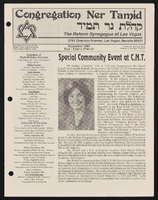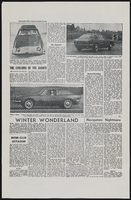Search the Special Collections and Archives Portal
Search Results

Paul M. Lytle interview, March 8, 1995 transcript
Date
Archival Collection
Description
Lytle discusses his birth in Salt Lake City, Utah, his early life in Overton, Nevada, moving around the Southwest United States, and returning to Overton in the early 1930s to work with the Civilian Conservation Corps. Subjects Lytle also talks about in the interview include road and campsite construction at the Valley of Fire State Park, stories about associates and relatives, and being enlisted as a male nurse with the United States Army during World War II. Lastly, Lytle talks about the construction of an exhibit building at Hoover Dam (Boulder Dam) originally used as a headquarters for soldiers during World War II to protect the dam.
Text
Bella Tyktin Stern Photographs
Identifier
Abstract
The Bella Tyktin Stern Photographs contain black-and-white photographs and negatives of Bella Tyktin Stern in locations around Las Vegas, Nevada from 1943 to 1960. The locations include Mt. Charleston Ski-Bar Ranch, the Last Frontier Hotel, Scotty's Castle in Death Valley, California, the Grand Canyon, Arizona, and Valley of Fire, Nevada.
Archival Collection
Alan Cummings Research Files
Identifier
Abstract
The Alan Cummings Research Files (1974-2004) are comprised of research files compiled by Cummings, an elementary school teacher for the Clark County School District (CCSD) in Southern Nevada. The files represent Cummings's work to persuade the Teacher's Health Trust, the employee benefit plan for the school district, to consider domestic partnership benefits for CCSD educators and administrators. Materials include personal correspondence, newspaper clippings, magazines, and court cases.
Archival Collection
Golden Agila Lions Club Records
Identifier
Abstract
The Golden Agila Lions Club Records (1996-2019) contain organizational and membership files for the Golden Agila Lions Club, a Filipino-American civic organization based in Las Vegas, Nevada. The collection includes information about chartering the organization as an official club and includes membership lists, newsletters, and records that document the Golden Agila Lions service and social activities. The collection includes newspaper clippings documenting the Golden Agila Lions Club and the Filipino community from various Las Vegas-based Filipino and Asian-American newspapers. Two issues of
Archival Collection
Josiah Edward Spurr Papers
Identifier
Abstract
Collection consists of an original manuscript, "Geology and Ore-Deposition at Tonopah, Nevada" by Josiah Edward Spurr (1870-1950) with hand-drawn diagrams, and letters discussing the donation of the manuscript. The manuscript, which was published in the journal Economic Geology in 1915, is a geological description of the Tonopah mining area; the Tonopah Mining Company is mentioned frequently. It is undated, but the publication date suggests it was written approximately 1913-1915.
Archival Collection
Ron Lurie Papers
Identifier
Abstract
The Ron Lurie Papers are primarily comprised of photographs, newspaper clippings, and daily planners from 1972 to 1990 that document Ron Lurie's political career as a city councilman and a mayor of Las Vegas, Nevada. The collection also includes a small amount of correspondence and ephemera, mainly letters that were mailed to Lurie along with photographs. The photographs in the collection depict events and activities that Lurie participated in, and the newspaper clippings document city and state politics in addition to Lurie's political career.
Archival Collection

Transcript of interview with Della Mae Rostine by Irene Rostine, October 31, 1991
Date
Archival Collection
Description
Della Mae Rostine left Missouri with her husband, Rocco, in 1942, and headed to Las Vegas. Happy to leave behind the hard life and instability the mining industry had to offer, after living in Las Vegas for the first year the couple settled in Henderson, Nevada, known as the townsite at that time. Della Mae’s oral history provides readers with a glimpse of what life was like for the 14,000-plus individuals and families who also moved to southern Nevada during the same period in order to make a living in the growing “war work” industry the area had to offer. Della Mae shares the hardships faced in finding housing, especially for families with children. She discusses challenges ranging from securing home furnishings to purchasing groceries, including the rations on gasoline and butter at that time. Della Mae also discusses her experiences with the Basic Magnesium plant where her husband was hired as a construction worker in the early days of the plant and where she would work briefly as a machinist making shell casings and monitoring the down time on the production line. She also touches briefly on the social opportunities the BMI plant, and later Rheem Manufacturing, offered to the workers and their families. When World War II ended, more than half of residents of the townsite left, leaving fewer than 7,000 people to form what would later become the city of Henderson, Nevada. Della Mae’s oral history is a brief overview of a family life which began when BMI was just getting off the ground and continued through the many changes that took place in the BMI complex and the town site over several decades. The timing of the Rostine family’s arrival and the fact that they stayed and made a permanent home in Henderson led to their designation as one of Henderson’s “founding families.”
Text

Jamey Stillings Resume / CV, June 17, 2016
Date
Archival Collection
Description
Text


